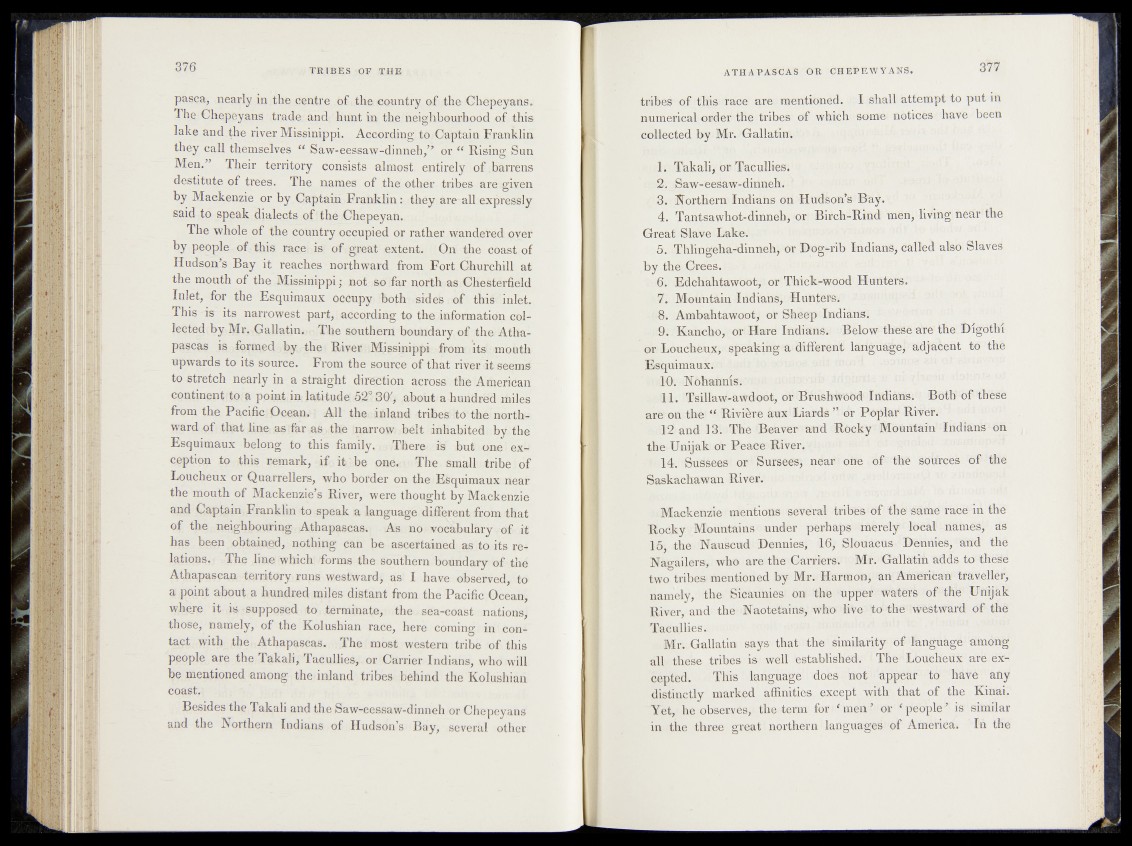
pasca, nearly in the centre oftheeountry of theiGhepeyans.
Tho Chepeyans trade and, hunt in the neighbourhood of this
lake and the river Missinippi. According to Captain Franklin
they call themselves “ Saw-eessaw-dinneh,” or “ Rising Sun
Men.” Their territory consists almost entirely of barrens
destitute of trees. The names of the other tribes are given
by Mackenzie or by.Captain Franklin: they are all expressly
said to speak dialects of the Chepeyan.
The whole of the country occupied or rather wandered over
by people of. this race, is of great extent. On the coast of
Hudson’s Bay it reaches northward from Fort Churchill at
the mouth of the Missinippi; not so’.far north asOhesierfield
Inlet, for the Esquimaux occupy, both • -sides of this inlet.
T h i s i t s narrowest part,. according to theiinformation collected;
by Mr. Gallatin,., The southern boundary, o f vthn Atha-
pascas is formed by the- River Missinippi from- itS'mouth
upwards to its source. From the source of that river »if seems
to stretch nearly in a straight direction across tbelAlhefMan
continent!to a point in latitude^ 1 8 9 ^ ,about a-hundred miles
from the Pacific: Ocean.: All the inland tribesMtO thei norths
ward of that line as :far a s . the marrow belt inhabited by. the
Esquimaux belong to this family., ; .There is but onefexfl
ception to this remark, if. it be one. . The small- tribe:of
Loucheux or Quarrellers, who border on the Esquimaux near
the mouth of Mackenzie’s River, were thought by Mackenzie
and Captain. Franklin to speak a language different, from that
of the neighbouring Athapascas. As no voeabularyfdfiiit
has hepp obtaingd, nothing pail be ascertained as to its re*
lations. > The line which forms the southern boundary of the
Athapascan territory runs westward, as I have observed, to
a> point about a hundred miles distant from the Pacific Ocean,
where it «^supposed to terminate) the sea-coast nations)
those, namely, of the Kolushian race, here coming in contact
with (the*. Athapascas. The most western tribe of this
people are the Takali, Tacullies, or Carrier Indians, who will
be mentioned among the inland tribes behind the Kolushian:
coast.
Besides the Takali and the Saw-eessaw-dinnehor Chepeyans
and the Northern Indians of Hudson’s Bay, several other
tribes of -this-Tape are mentioned. | I shall attempt to put in
numerical order the tribes of which some' notices' have been
collected by Mr. . Gallatin:'»
gf^T/Pakali/óïs Taeulfiesv e
i- 2.jSaw-'eesaw-dinneh. ^
3. Northern Indians on Hudio&’S Bay. y,‘5
4. Tantsawhot-dinneh, or Birch^Rind? men, living, nedf the
Great ■ Slave Lake.1' £
iC'&pThlingeha-dinneh.; or Bogs-rlb Indians, called al'só; Slaves
thèiQreeè.fv
ïnêb-Edehahtawoot,1 or Thick-wood Huntefs.'- *
71 Mountain. Indianèf Himfei«;/' j
' 8. Ambahtawoot, or Shtóöp lndiansï
-ii9i;Kahcho, or! Hare Indians;? Bélow^tbëëê efre the Blf’öthl
or^Éouchéu^, speaking -a different lati|ü^e^%djsiefltt tffffhe
Esquimaux; n
* s n p | NAtmhlnl^cm
11. Tsillaw-awdoot, of BtóshritOÖ# Indi^sfet Bdffl^bf^ttesë
are on the* ^Riviëre tmx Liards ’’ ér Pojdai4 R#^Wr -
sdl2£and l8i The Beaver afnd ^e^^ÉIóéfiijAi'-'-IhdléHÖ'ï'èfi
tbed&njak dr Peaee>®iiver€ | |
14-. SusSees- or ISursees; ndarf ofte vbfi' ttie söurcës óf the
Saskaelmwan River.
ü Mackenzie mention® -several tribes‘of thetedriie race-id thé
Soöky Mountains undér ' ès.
IS; thevNauScud; Denniesi dfy Sfettactis-. Dèhiiïes, ’aüd thê
Nagailers, who are the Carrfersu - 'Mr.1 Gallatin adds to-the¥e
two tribes-mentioned by Mr. Harmonf'!&if:AMMfea%1 travêïlé^
namely, *^he, SietbUhiesf on the upper iiï'a&ëék m f’the’ IMjak
River, and? the-Naotetainsy who; lifyeP^td the'TWëstward óf thê
Tacullies^;'.'
?I Mr. Gallatin says that theosimilarffj^ amóhg1
all- these tribes is well êstablishêd. i The^ Lbübhëö^ arfeë^H
éepted. This language- i'doeS'£!®q1?>ikppeiar -~tó ‘havé afty
distinctly marked affinities^ except with that of the Kipai.
Yet, he observes, ! the term for *‘ men ’ or ^pëb^le^is similar
in the three great northern Üaügu#g®i of AtóèMèd» In the